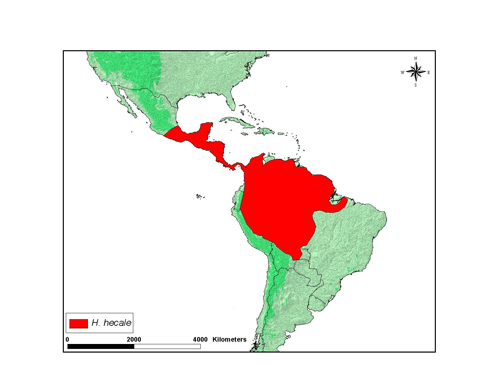Heliconius hecale
Margarita BeltránIntroduction
Etymology: Hecale was a priestess of Zeus in Athens. She had offered to sacrifice to Zeus if Theseus would come back safe after meeting the Marathonian Bull, but she died before Theseus' return (Hecale).
Characteristics
Early stages: Eggs are yellow and approximately 1.9 x 0.9 mm (h x w). Females usually place eggs singly on growing shoots and tendrils of the host plant. Mature larvae have a white body with black scoli, orange head, and all spines, spiracles and dots in the dorsum are black; length is around 1.8 cm. Caterpillars are gregarious in small numbers (Brown, 1981). Pupae are brown with three gold spots on the dorsum, the thorax is strongly bowed and have five pairs of black spines in the abdomen. The head has short head horns and the antennae have many short black spines (DeVries, 1997).
Geographical Distribution
Heliconius hecale is distributed from Central America to the Amazon. The map below shows an approximate representation of the geographic distribution of this species. The original data used to draw these maps are derived from Brown (1979) which is available at Keith S. Brown Jr. (1979). Ecological Geography and Evolution in Neotropical Forests.
Habits
H. hecale occurs from sea level to 1,400 m in tall forests. Usually individuals fly rapidly in the canopy and erratically in the lowerstory. Females mate multiply and adults roost solitarily or in loose groups at night at 2-10 m above ground on twigs or tendrils.
Hostplant: H. hecale larvae feed primarily on plants from the subgenera Granadilla and Distephana (Passifloraceae), as a secondary source H. hecale use Astrophea and in laboratory conditions they accept Dysosmia (Passifloraceae) (Brown, 1981). In Panama H. hecale most commonly feeds on Passiflora vitifolia (C. Jiggins, pers obs.)
References
Brown K. S. 1981 The Biology of Heliconius and Related Genera. Annual Review of Entomology 26, 427-456.
Fabricius J. C. [1745_1808] 1776. Genera insectorvm eorvmqve characteres natvrales secvndvm nvmervm, figvram, sitvm et proportionem omnivm partivm oris adiecta mantissa speciervm nvper detectarvm. Chilonii, Mich. Friedr. Bartsch. [xvi] + 310 pp.
DeVries P. J. 1997 The Butterflies of Costa Rica and Their Natural History, Volume I: Papilionidae, Pieridae, Nymphalidae Princeton University Press, Baskerville, USA.
Hecale. Greek Mythology Link. http://homepage.mac.com/cparada/GML/001ShortEntries/SEEurythemis.html [Accessed July 16, 2008].
Title Illustrations

| Scientific Name | Heliconius hecale felix |
|---|---|
| Specimen Condition | Dead Specimen |
| Sex | Male |
| View | Dorsal |
| Collection | Gerardo Lamas |
| Image Use |
 This media file is licensed under the Creative Commons Attribution-NonCommercial-ShareAlike License - Version 3.0. This media file is licensed under the Creative Commons Attribution-NonCommercial-ShareAlike License - Version 3.0.
|
| Copyright |
©

|
| Scientific Name | Heliconius hecale felix |
|---|---|
| Specimen Condition | Dead Specimen |
| Sex | Male |
| View | Ventral |
| Collection | Gerardo Lamas |
| Image Use |
 This media file is licensed under the Creative Commons Attribution-NonCommercial-ShareAlike License - Version 3.0. This media file is licensed under the Creative Commons Attribution-NonCommercial-ShareAlike License - Version 3.0.
|
| Copyright |
©

|
| Scientific Name | Heliconius hecale felix |
|---|---|
| Specimen Condition | Dead Specimen |
| Sex | Female |
| View | Dorsal |
| Collection | Gerardo Lamas |
| Image Use |
 This media file is licensed under the Creative Commons Attribution-NonCommercial-ShareAlike License - Version 3.0. This media file is licensed under the Creative Commons Attribution-NonCommercial-ShareAlike License - Version 3.0.
|
| Copyright |
©

|
| Scientific Name | Heliconius hecale felix |
|---|---|
| Specimen Condition | Dead Specimen |
| Sex | Female |
| View | Ventral |
| Collection | Gerardo Lamas |
| Image Use |
 This media file is licensed under the Creative Commons Attribution-NonCommercial-ShareAlike License - Version 3.0. This media file is licensed under the Creative Commons Attribution-NonCommercial-ShareAlike License - Version 3.0.
|
| Copyright |
©

|
About This Page

University of Cambridge, Cambridge, UK
Correspondence regarding this page should be directed to Margarita Beltrán at
Page copyright © 2010
 Page: Tree of Life
Heliconius hecale .
Authored by
Margarita Beltrán.
The TEXT of this page is licensed under the
Creative Commons Attribution-NonCommercial-ShareAlike License - Version 3.0. Note that images and other media
featured on this page are each governed by their own license, and they may or may not be available
for reuse. Click on an image or a media link to access the media data window, which provides the
relevant licensing information. For the general terms and conditions of ToL material reuse and
redistribution, please see the Tree of Life Copyright
Policies.
Page: Tree of Life
Heliconius hecale .
Authored by
Margarita Beltrán.
The TEXT of this page is licensed under the
Creative Commons Attribution-NonCommercial-ShareAlike License - Version 3.0. Note that images and other media
featured on this page are each governed by their own license, and they may or may not be available
for reuse. Click on an image or a media link to access the media data window, which provides the
relevant licensing information. For the general terms and conditions of ToL material reuse and
redistribution, please see the Tree of Life Copyright
Policies.
- First online 18 February 2007
- Content changed 12 August 2008
Citing this page:
Beltrán, Margarita. 2008. Heliconius hecale . Version 12 August 2008 (under construction). http://tolweb.org/Heliconius_hecale/72904/2008.08.12 in The Tree of Life Web Project, http://tolweb.org/







 Go to quick links
Go to quick search
Go to navigation for this section of the ToL site
Go to detailed links for the ToL site
Go to quick links
Go to quick search
Go to navigation for this section of the ToL site
Go to detailed links for the ToL site